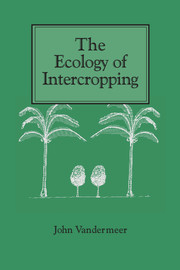Book contents
- Frontmatter
- Contents
- Preface
- 1 Introduction: intercrops and ecology
- 2 The measurement of intercrop performance
- 3 The competitive production principle
- 4 Facilitation
- 5 Mechanisms of the competitive production principle
- 6 The environments modified to produce facilitation
- 7 Special problems in intercrops involving perennials
- 8 Weeds and intercrops
- 9 Variability and intercrops
- 10 Planning intercrops – a phenomenological approach
- 11 Planning intercrops – a mechanistic approach
- 12 Critical research directions for the future
- References
- Author index
- Subject index
6 - The environments modified to produce facilitation
Published online by Cambridge University Press: 05 August 2012
- Frontmatter
- Contents
- Preface
- 1 Introduction: intercrops and ecology
- 2 The measurement of intercrop performance
- 3 The competitive production principle
- 4 Facilitation
- 5 Mechanisms of the competitive production principle
- 6 The environments modified to produce facilitation
- 7 Special problems in intercrops involving perennials
- 8 Weeds and intercrops
- 9 Variability and intercrops
- 10 Planning intercrops – a phenomenological approach
- 11 Planning intercrops – a mechanistic approach
- 12 Critical research directions for the future
- References
- Author index
- Subject index
Summary
It seems to be the case, as emphasized in Chapters 3 and 5, that many if not most cases of intercrop advantage are due to the competitive production principle. But many known cases, and probably many that have not yet been sufficiently studied, might very well be due to the modification of some environmental factor, in a positive way, by one of the crops. Certainly, the more spectacular cases must involve some sort of facilitation since competitive production can maximally yield an LER of 2.0, and any individual relative yield can never be greater than 1.0 (see Chapters 2 and 3). In those frequent cases where a relative yield is greater than 1.0, the facilitative production principle must be operative, in some way. This chapter discusses those environmental factors that are typically thought to be modified when facilitation is operative.
Nitrogen
Since many commonly occurring intercrop systems involve a nodulating legume, and since they frequently yield better than their monocultural components (Trenbath, 1976; Snaydon & Harris, 1979; Walker et al., 1954; Allen & Obura, 1983), it is most natural to suspect that nitrogen is somehow involved. Just examining the extensive literature on grass–clover combinations (e.g. Simpson, 1965; Stern & Donald, 1962; Ennik, 1969; Cowling & Lockyer, 1967; Camlin et al., 1983), one is left with little doubt that nitrogen must be of overwhelming importance. But nitrogen can be involved in two distinct ways.
- Type
- Chapter
- Information
- The Ecology of Intercropping , pp. 86 - 105Publisher: Cambridge University PressPrint publication year: 1989



